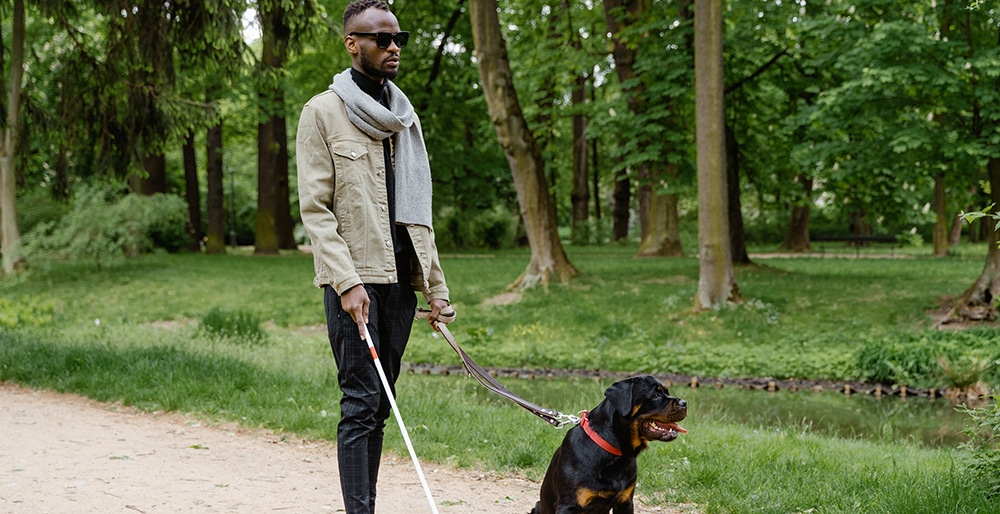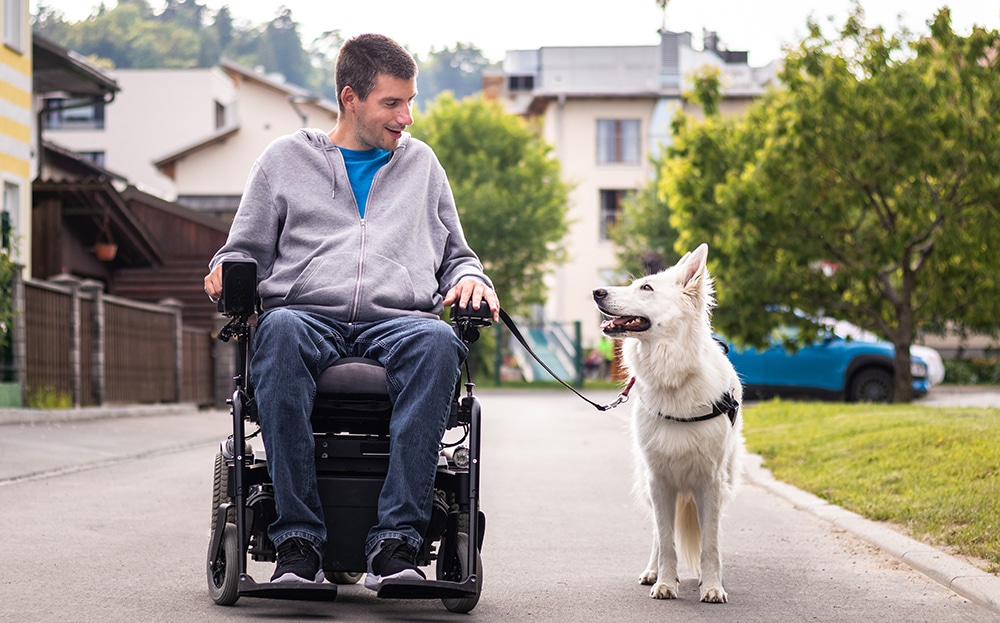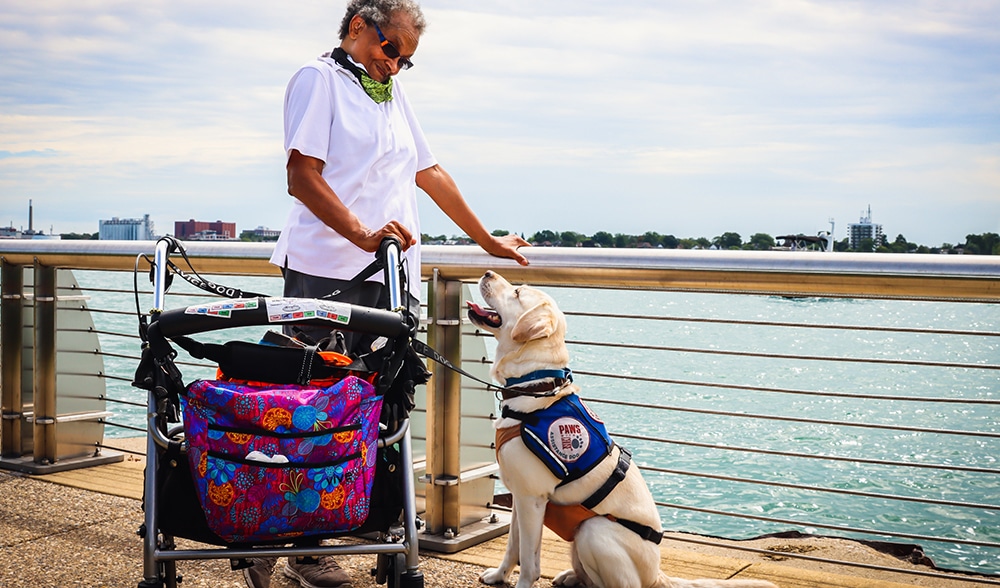Dogs contain the ability to help humans with their physical, neurological or mental health needs. Assistance dogs have been around since the 1750s when a Paris hospital first used guide dogs for the visually impaired. Since then, training has expanded greatly to help people with multiple disabilities. National Assistance Dog Week celebrates the service dog’s hard work and dedication.
This blog covers the different types of service dogs and what they do, best breeds for service dogs and how to act around a service dog.
Types of Service Dogs and What They Do
Guide Assistance Dogs
Seeing-eye dogs are what people normally think of when they think of a service dog. Guide dogs help the visually impaired and blind to avoid obstacles and people. These types of service dogs have a special harness with a handle on it to guide their handler through crowded areas and unfamiliar spaces. The handler learns the proper verbal and hand signals during mobility training to clearly communicate with their service dog on how and where they want to travel.

Hearing Assistance Dogs
People who are deaf and hearing impaired can greatly benefit from having a hearing dog. These service dogs are trained to alert their handler to noises such as doorbells, alarms, oven timers, crying babies, phone alerts and much more. The dog hears the noise, touches their human and leads their human to the source of the noise. Hearing dogs can also alert their handler to noises in the outside world such as sirens and someone calling their handler’s name.

Mobility Assistance Dogs
This type of service dog can assist those who have a brain injury, cerebral palsy, multiple sclerosis, muscular dystrophy, arthritis, Parkinson’s disease, spinal cord injury, etc. Mobility assistance dogs grab objects for their handler, press buttons on automatic doors, turn on and off lights, open and close doors and even help pull a wheelchair up a ramp. These service dogs can also serve as a brace for people who have trouble with balance and are trained to find and alert others when human help is necessary.

Diabetic Alert Dogs
A diabetic’s blood sugar can rise and fall. A diabetic alert dog can smell the changes in scent when a person goes through a hyperglycemic or hypoglycemic event. The service dog then alerts their handler to take action before the person develops severe symptoms and the situation becomes dangerous. The dog also is trained to alert others if their person needs assistance.
Seizure Response Dogs
Seizures are hard to predict in many cases. Having a seizure response dog can help in those unpredictable moments. This service dog is trained to bark for help, press an alarm system during their person’s seizure, bring their person out of an unsafe area, break the person’s fall to prevent head trauma, hold their handler in a safe position and may bring medicine or a phone to their person once the seizure episode has subsided.
Psychiatric Service Dogs
Depression, anxiety and PTSD may require help from a service dog. Psychiatric service dogs ease claustrophobia by acting as a non-protective barrier and leading their person to a more spacious area when they feel their handler is experiencing anxiety. These service dogs can assess threats by entering an unknown space first and conducting a quick room search for people with PTSD.
The dogs are trained to provide therapeutic and tactile distraction by applying pressure with their bodies onto their handler’s chest or lap. This pressure encourages emotional regulation and eases anxiety. They can remind their handler to take their prescribed medication and act as a support for those who’s medication can make them feel unbalanced. These service dogs can wake up and ease out their handler from a night terror.
Psychiatric service dogs can get their human to leave the house, exercise and provide a continued sense of companionship. All of these have been shown to help people to begin to take care of themselves and interact with the world around them.

Allergy Detection Dogs
Dogs have amazing and powerful noses. Through training, these service dogs can detect the odor of allergens like peanuts, eggs or gluten far before their handler even touches the food. When an allergy detection dog smells the allergen, they alert their handler to the danger. These service dogs hold important medical information and medication in the pockets of their vests to provide easy access for others to help their person.

Autism Service Dogs
Children are normally paired up with these types of service dogs. Autism service dogs help autistic children increase their opportunities to develop their language and social skills. The dog acts as an ice breaker and provides a sense of predictability to the child’s day. Autism service dogs can be trained to interrupt harmful behavior and keep the child from running off to dangerous areas.
Best Breeds for Assistance Dogs
A service dog needs to be intelligent, loyal, a quick learner, easy to train, enjoys working, eager to please and gentle. The breeds that typically show these behavioral traits are Labradors, golden retrievers, German shepherds, poodles, boxers, Great Danes, border collies, Bernese mountain dogs, Pomeranians and Portuguese water dogs.
The type of breed that is used for a particular disability depends on the needs of the individual handler. For example, a Great Dane is perfect for those who need a service dog to brace a fall, for walking balance support or to provide a non-protective barrier in public. Organizations that train and provide service dogs to the public can help the individual to find the correct canine fit for them.
These dogs are trained from one to two years and start training at six months to a year old. The service dog works until they are no longer able to perform their necessary training and usually retire around 10 years old.

How to Act Around a Service Dog
An adorable dog is hard to resist, but it is important to remember that service dogs are working dogs. They have a major role in the safety of their person’s life and must be given space to do their job without distractions.
In public a service dog displays the behavioral traits of being consistently alert to only their handler, disciplined, clearly trained and maintaining a stable, even temperament. Service dogs are not required by the ADA to show any identification, so if you notice any or more of these traits in a dog, ask before petting the canine. Some handlers are okay with a quick head pat and others prefer their dog stays focused.
Assistance Dogs Provide Independence
A service dog provides a non judgmental and loving companion that provides everyday independence and sense of control for their handler. They help their person navigate through the world and bring a sense of security. These dogs have an important job that they love. Always respect the wishes and privacy of the handler when encountering a service dog in public.




